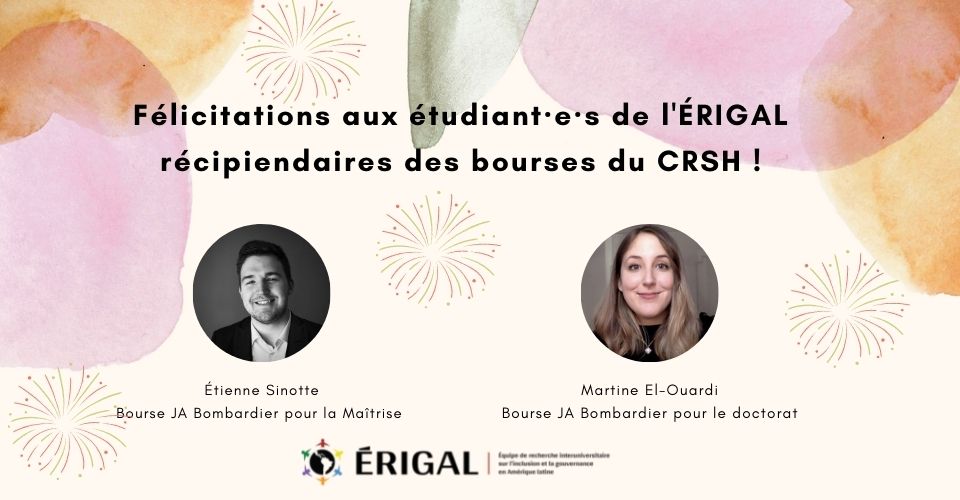Congratulations to the ÉRIGAL students who received SSHRC scholarships!

Étienne Sinotte is a master's student in political science at the Université de Montréal under the direction of Françoise Montambeault, and holds a bachelor's degree in applied political studies from the Université de Sherbrooke. He is particularly interested in Latin American political regimes, North-South relations and international development. He is also interested in the role that non-state organizations play in the relationship between governments and the population, particularly indigenous communities.
Etienne is interested in the adaptive capacity of Peruvian intermediary non-governmental organizations (NGOs) in response to COVID-19. His research, rooted in critical development theory, has two main objectives. First, it aims to expose the effects of the COVID-19 pandemic on Peruvian NGOs that provide services to indigenous communities in the department of Cusco and link them to local governments. Second, it seeks to observe the ability - or inability - of these NGOs to adapt, their coping strategies, and the internal and external factors that made this adaptation possible or impossible.
Martine El Ouardi is currently a master's student in political science at the Université de Montréal, under the supervision of Françoise Montambeault. She holds a bachelor's degree in sociology from the Université de Montréal and has participated in several research projects in the sociology of culture. She is particularly interested in the relationship to politics and informal citizen participation in urban space.
As a future PhD student, she is interested in how the occupation of public space in Paris allows migrants and the associations that help them to fight against their exclusion (social, political and spatial).
Indeed, since 2015, the presence of migrants in Paris has been treated, by the media and politicians, under the prism of the crisis. Although they are not significantly more numerous than in previous decades, the inadequacy of reception policies increases the proportion of homeless migrants (Makaremi, 2018). Not being citizens, they find themselves outside the "normal" rule of law and at the mercy of the discretionary power of public authorities (Agamben, 1998; Monforte and Dufour, 2013). In addition to making access to housing and employment difficult, this institutional exclusion is accompanied by spatial segregation (Balibar and Wallerstein, 1991); migrants are thus mostly found in the disadvantaged northern suburbs of the city and are regularly chased away by law enforcement when they camp in the more central neighborhoods (Byrne, 2021). However, there are many practices that take place in public space that challenge this natural order of domination (Rancière, 2000), whether or not this is the primary goal. Among these practices, the occupation of public space makes it possible to symbolically stage the presence of migrants in public space and thus refuse the invisibility assigned to them (Monforte and Dufour, 2013). These occupations are most often carried out in partnership with migrant aid associations, which master certain registers of militant action. Using a theoretical framework inspired by symbolic interactionism (Mead, 1967) and Henri Lefebvre's (1974) theory of space, she studies three idealistic forms of occupation of public space: the encampment, the demonstration, and street art. By contrasting these three forms of occupation, the study will capture the range of possible variations in the ways in which migrants organize to resist their exclusion on a daily basis and make collective claims. Methodologically, this research will use an inductive ethnographic approach, relying on participant observation (which will begin with involvement in migrant aid associations) and interviews with migrants, non-migrant members of the associations and street artists.
Congratulations to both of them !


